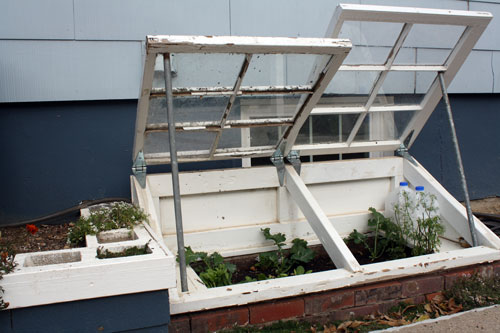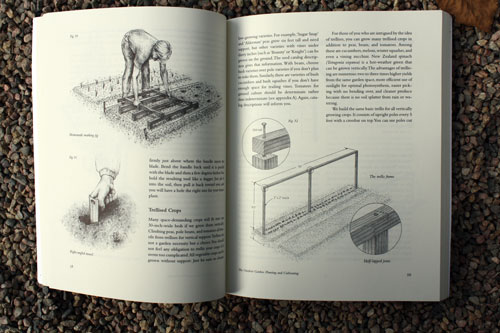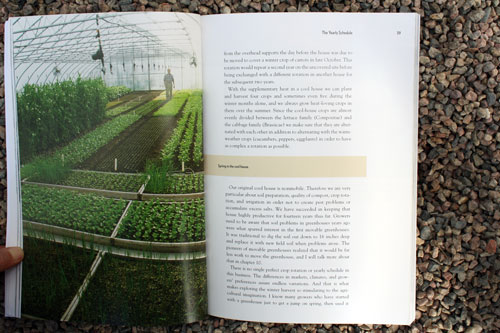In Which I Learn to Grow Food in Winter (Book Review and Giveaway!)
I’ve been tilling this bit of earth for more than a decade. Most years, I am ready for a rest and I happily embrace the coming winter, the killing frost, the layer of snow that keeps the garden sleeping for half of the year. These are the months when I catch up on my knitting projects and TBR (To-Be-Read) Pile.
This year, though, I feel a little sad and not quite ready to let go of the fresh goodness of the garden. In summers past I’ve been able to put up some of the veg against the winter months. I froze tomatoes and beans and peaches and berries and peas. I dehydrated herbs and braided garlic and onions. By this, we ate pretty well even in winter. But as my family grows, so do their appetites and I only had one bag of tomatoes and some basil to freeze this summer. Everything else just got eaten. Plain and simple.

I found myself faced with either a long winter of scurvy or of buying greens from the grocery store (which I find either bland and tasteless, or so expensive that I consider investing in kale shares). Taking matters into my own hands, I decided to try my hand at winter gardening. And Chelsea Green offered me just the books I needed to get started: Four-Season Harvest and The Winter Harvest Handbook both by one of the fathers of local, organic produce Eliot Coleman.* And Chelsea Green wants to share the joys of winter gardening with you, too! Find the details about the book giveaway at the end of the post.
I spent two days devouring these two books, in which Coleman distills the essence of his many years of experience. He himself developed many of the techniques and even the tools he shares, and he still uses them on his farm in Maine today. Coleman passionately believes that knowledge should be shared and not hoarded, and he does exactly that, giving the reader insight into how he runs his four-season farm in Maine.
You’d be within your rights to wonder what the difference is between the two books, and whether you need both of them. No, you don’t need both. You don’t really even need one of them to get started on a winter garden. Put a box of potatoes in the basement and you’ve got a root cellar. Throw a blanket over your spinach crop and you’ve got a cloche. But Coleman’s books will give you all the tips you need to keep your potatoes from rotting and your spinach from freezing. If that’s your goal, then one of these books should definitely be on your shelf. Which one will depend on your garden-size, your budget, and your time.
I find Four-Season Harvest (first published in 1992) the best suited for my purposes. There is plenty of information that made me think “I can do that”, things that are accessible to home gardeners: root cellars, cold frames, hoop houses (large and small). But it also has just enough information that is beyond my reach to make me want to do more.

The Winter Harvest Handbook (published in 2009), in my opinion, is better suited to small-scale commercial growers. Most of this book, though similar in content to Four-Season Harvest, is radically different in scale. This makes sense, because Four-Season Harvest is based on Coleman’s farming practices from the 1990’s and Winter Harvest Handbook is based on his farming practices a decade later when his farm is larger and he has more employees. So much of the content in The Winter Harvest Handbook felt so far beyond what I could manage or desire for my 1/5 of an acre property. For example, the A-frame greenhouse he suggests for the compost pile would easily cover my entire garden. A couple of his large greenhouses would shelter my entire property.
So while the spirit of the information in both books is the same, and much of the content is also the same, the scale is vastly different. Are you a home gardener who grows for your family and friends? Go for the Four-Season Harvest. Are you a small-scale commercial grower growing for your CSA or farmers’ market customers? Go for The Winter Harvest Handbook.
Both books include thorough appendices with climate maps, planting charts, and lists of suppliers of everything from tools to seeds. Both books contain lots of stories and anecdotes from the Colemans’ travels, research, and experience. I find that the stories and anecdotes strike a nice balance with the charts and diagrams, making the books more informative than a memoir, but more readable than a textbook.
Four-Season Harvest includes a thoroughly detailed list of fruit and veg to consider growing for the winter (it’s way longer than you’d expect!). Most of the book is illustrated with charming, black and white line-drawings, though there is a center section with a few color photos. The drawings are clear and include measurements and construction details when appropriate, so that if you wanted to build your own Coleman-esque greenhouse, you could do so with this book and a good handyman. The chapters on planning, site-preparation, and cultivation are quite thorough and offer something to all levels of gardeners.

The Winter Harvest Handbook goes into details of marketing, economics, and the politics of the organic label. I thoroughly enjoyed reading the chapter on historical methods of winter gardening in Europe and there is a nice chapter on tools for the small farm, some of them designed by Coleman himself. He goes into quite a bit of detail on how his moveable greenhouses work. This was fascinating for me to read, but so utterly impractical for my small garden that it wasn’t of much use to me. I think one would need more information to know how to build one, but this book could certainly tell you all you need to know about how to use one.

When these books arrived in my mailbox, I already had a crop of winter greens flourishing in the bay window of the living room. I hadn’t quite decided what to do with them when they’d outgrown the starter pots. Thanks to inspiration from Coleman’s books, I decided to put up a small hoop house next to the coldframe on the south side of our house. We have spinach and corn salad in the coldframe, and kale, chard, bok choy, and cabbage in the hoop house.

I imagine I will still have the time for a few knitting projects and the top two or three books off of the TBR Pile. The pace of the winter garden is, by nature, a bit slower than other seasons. But I also plan to have some fresh greens to serve me and my family this winter. It seems like a fair trade.
* Review posts are my opinions on items that were sent to me free of charge. The items were given to me, but the thoughts and opinions are my own. I only provide reviews of items that I find to be truly worthy of recommendation.
